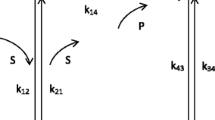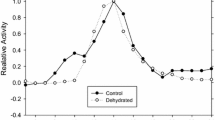Abstract
Glyceraldehyde-3-phosphate dehydrogenase (GAPDH) from Thermotoga maritima (TmGAPDH) is a thermostable enzyme (T m = 102°C), which is fully active at temperatures near 80°C but has very low activity at room temperature. In search for an explanation of this behavior, we measured the conformational flexibility of the protein by hydrogen–deuterium exchange and compared the results with those obtained with GAPDH from rabbit muscle (RmGAPDH). At room temperature, the conformational flexibility of TmGAPDH is much less than that of RmGAPDH, but increases with increasing temperature and becomes comparable to that of RmGAPDH near the physiological temperature of Thermotoga maritima. Using the available three-dimensional structures of the two enzymes, we compared the B factors that reflect the local mobility of protein atoms. The largest differences in B factors are seen in the coenzyme and NAD binding regions. The likely reason for the low activity of TmGAPDH at room temperature is that the motions required for enzyme functions are restricted. The findings support the idea of “corresponding states” which claims that over the time span of evolution, the overall conformational flexibility of proteins has been preserved at their corresponding physiological temperatures.




Similar content being viewed by others
References
Bolotina IA, Vol’kenshtein MV, Zavodszky P, Markovich DS (1966) Polarimetric studies of the conformational changes in d-glyceric aldehyde-3-phosphate dehydrogenase. Biokhimiia 31:649–653
Carugo O, Argos P (1999) Reliability of atomic displacement parameters in protein crystal structures. Acta Crystallogr D Biol Crystallogr 55:473–478
Conway A, Koshland DEJ (1968) Negative cooperativity in enzyme action. The binding of diphosphopyridine nucleotide to glyceraldehyde 3-phosphate dehydrogenase. Biochemistry 7:4011–4023
Cowan-Jacob SW, Kaufmann M, Anselmo AN, Stark W, Grütter MG (2003) Structure of rabbit-muscle glyceraldehyde-3-phosphate dehydrogenase. Acta Crystallogr D Biol Crystallogr 59:2218–2227
Dalziel K, McFerran NV, Wonacott AJ (1981) Glyceraldehyde-3-phosphate dehydrogenase. Philos Trans R Soc Lond B Biol Sci 293:105–118
Demchenko AP (1997) Breaks in Arrhenius plots for enzyme reactions: the switches between different protein dynamics regimes? Comments Mol Cell Biophys 9:87–112
Hammes-Schiffer S (2002) Impact of enzyme motion on activity. Biochemistry 41:13335–13343
Hara MR, Agrawal N, Kim SF, Cascio MB, Fujimuro M, Ozeki Y, Takahashi M, Cheah JH, Tankou SK, Hester LD, Ferris CD, Hayward SD, Snyder SH, Sawa A (2005) S-nitrosylated GAPDH initiates apoptotic cell death by nuclear translocation following Siah1 binding. Nat Cell Biol 7:665–674
Hernandez G, Jenney FEJ, Adams MW, LeMaster DM (2000) Millisecond time scale conformational flexibility in a hyperthermophile protein at ambient temperature. Proc Natl Acad Sci USA 97:3166–3170
Huber R, Langworthy TA, Konig H, Thomm M, Woese CR, Sleytr UB, Stetter KO (1986) Thermotoga maritima sp.nov. represents a new genus of unique extremely thermophilic eubacteria growing up to 90 degrees C. Arch Microbiol 144:333
Jaenicke R (2000) Do ultrastable proteins from hyperthermophiles have high or low conformational rigidity? Proc Natl Acad Sci USA 97:2962–2964
Jaenicke R, Závodszky P (1990) Proteins under extreme physical conditions. FEBS Lett 268:344–349
Korndörfer I, Steipe B, Huber R, Tomschy A, Jaenicke R (1995) The crystal structure of holo-glyceraldehyde-3-phosphate dehydrogenase from the hyperthermophilic bacterium Thermotoga maritima at 2.5 A resolution. J Mol Biol 246:511–521
Lakatos S, Závodszky P (1976) The effect of substrates on the association equilibrium of mammalian d-glyceraldehyde 3-phosphate dehydrogenase. FEBS Lett 63:145–148
Leslie AG, Wonacott AJ (1984) Structural evidence for ligand-induced sequential conformational changes in glyceraldehyde 3-phosphate dehydrogenase. J Mol Biol 178:743–772
Privalov PL (1979) Stability of proteins: small globular proteins. Adv Protein Chem 33:167–241
Rehaber V, Jaenicke R (1992) Stability and reconstitution of d-glyceraldehyde-3-phosphate dehydrogenase from the hyperthermophilic eubacterium Thermotoga maritima. J Biol Chem 267:10999–11006
Szilágyi A, Závodszky P (1995) Structural basis for the extreme thermostability of d-glyceraldehyde-3-phosphate dehydrogenase from Thermotoga maritima: analysis based on homology modelling. Protein Eng 8:779–789
Tisdale EJ, Artalejo CR (2007) A GAPDH mutant defective in Src-dependent tyrosine phosphorylation impedes Rab2-mediated events. Traffic 8:733–741
Truhlar D, Kohen A (2001) Convex Arrhenius plots and their interpretation. Proc Natl Acad Sci USA 98:848–851
Venyaminov SY, Rajnavölgyi E, Medgyesi GA, Gergely J, Závodszky P (1976) The role of interchain disulphide bridges in the conformational stability of human immunoglobulin G1 subclass. Hydrogen–deuterium exchange studies. Eur J Biochem 67:81–86
Vihinen M (1987) Relationship of protein flexibility to thermostability. Protein Eng 1:477–480
Williams DH, Zhou M, Stephens E (2006) Ligand binding energy and enzyme efficiency from reductions in protein dynamics. J Mol Biol 355:760–767
Wrba A, Schweiger A, Schultes V, Jaenicke R, Závodszky P (1990) Extremely thermostable d-glyceraldehyde-3-phosphate dehydrogenase from the eubacterium Thermotoga maritima. Biochemistry 29:7584–7592
Zavodszky P, Abaturov LB, Varshavsky YM (1966) Structure of glyceraldehyde-3-phosphate dehydrogenase and its alteration by coenzyme binding. Acta Biochim Biophys Acad Sci Hung 1:389–402
Závodszky P, Johansen JT, Hvidt A (1975) Hydrogen-exchange study of the conformational stability of human carbonic-anhydrase B and its metallocomplexes. Eur J Biochem 56:67–72
Závodszky P, Jaton JC, Venyaminov SY, Medgyesi GA (1981) Increase of conformational stability of homogeneous rabbit immunoglobulin G after hapten binding. Mol Immunol 18:39–46
Závodszky P, Kardos J, Svingor A, Petsko GA (1998) Adjustment of conformational flexibility is a key event in the thermal adaptation of proteins. Proc Natl Acad Sci USA 95:7406–7411
Zheng L, Roeder RG, Luo Y (2003) S phase activation of the histone H2B promoter by OCA-S, a coactivator complex that contains GAPDH as a key component. Cell 114:255–266
Acknowledgments
Péter Závodszky was supported by the Hungarian National Science Foundation (OTKA) Grants T046412, and NI-61915. A.S. was supported by a Bolyai János fellowship.
Author information
Authors and Affiliations
Corresponding author
Additional information
Regional Biophysics Conference of the National Biophysical Societies of Austria, Croatia, Hungary, Italy, Serbia, and Slovenia.
Rights and permissions
About this article
Cite this article
Hajdú, I., Bőthe, C., Szilágyi, A. et al. Adjustment of conformational flexibility of glyceraldehyde-3-phosphate dehydrogenase as a means of thermal adaptation and allosteric regulation. Eur Biophys J 37, 1139–1144 (2008). https://doi.org/10.1007/s00249-008-0332-x
Received:
Revised:
Accepted:
Published:
Issue Date:
DOI: https://doi.org/10.1007/s00249-008-0332-x




